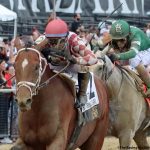MJC to offer Preakness future wager
In recent days, Maryland Jockey Club (MJC) linemaker Keith Feustle has been puzzling over how to set the morning line for a wager new to Maryland.
For the first time, the MJC will offer a parimutuel future win wager on the Grade 1 Preakness Stakes to be run May 20 at Pimlico Race Course. The new wager, which will have an 18% takeout, was approved April 4 by the Maryland Racing Commission.
The wager will kick off April 28, MJC Acting President Mike Rogers told the Commission, and close May 6 prior to the running of the Kentucky Derby. It can include up to 40 separate betting interests, though Rogers guesstimated 30 or so in its maiden voyage. One of those interests typically is “all other three-year-olds” not listed. More information will be available on the Preakness website and in daily racing programs at facilities that accept the wager.
“We’re excited. We think we’ve improved the [Preakness weekend] wagering menu,” Rogers said, also citing the addition of new Pick-4 and Pick-5 opportunities on Preakness day and Black-Eyed Susan day, which is the Friday before the Preakness.
Bettors who participate in future wagers are asked to pick the winner of a race well in advance of the race – in fact, in advance of knowing exactly who will be in the race. That uncertainty can lead to better prices for the bettor, but it also means that bettors lose if horses don’t run for whatever reasons.
The Preakness future wager will have a $2 minimum bet.
Churchill Downs has offered a future wager on the Kentucky Derby for 25 years and on the Kentucky Oaks for 20. In seven of the last nine years, the Derby winner paid more in the final future pool than he did on Derby day; the exceptions to that were Rich Strike, who paid $39.00 as part of the field of all others but returned $163.60 to win on Derby day, and Country House, who paid just $40 in the final Derby future wager but whose surprise win, via disqualification, netted backers $132.40 on the first Saturday in May.
In his report, Rogers also told the Commission that the MJC has been working on the racing strip at Laurel to prepare for the end of the winter and onset of spring. That work includes repairs to the base near the first finish line, a spot which has been an issue for some time.
Rogers also said that the company’s negotiations with the state horsemen’s group, the Maryland Thoroughbred Horsemen’s Association, “are continuing” in what he termed a “positive” direction. The track and horsemen had operated under the so-called “10-year deal” governing racing through the end of last year, an agreement which has been extended through June 30. Racing could shut down following the expiration of the deal if no agreement is reached, but Rogers said he had “no concerns.”
The discussions around that agreement take place in a larger context involving the future of racing in the state. The project to revitalize Laurel and Pimlico has run aground amid rising costs, supply chain issues, and industry’s own struggles to reach accord on the shape and development of the projects.
In other business, the Commission also formalized its agreement with the Horseracing Integrity and Safety Authority/Horseracing Integrity and Welfare Unit. That agreement calls for the Commission to continue to collect blood and urine samples on HIWU’s behalf, with the latter responsible for the testing and adjudication of positives. With the new drug rules on hold for at least 30 days following a court ruling, however, the agreement will not take effect until at least May 1. It will be in effect through the end of 2023.
Tuesday’s meeting marked the final meeting as a member of the Commission for longtime member David Hayden, who had chaired the Maryland Bred Fund, and for Dr. Tom Bowman, who had led the health and safety committee.
Those two, who Hayden said had a combined total of more than 100 years in the industry, were driven by “their passion, their love for the industry,” chairman Michael Algeo said.
LATEST NEWS














